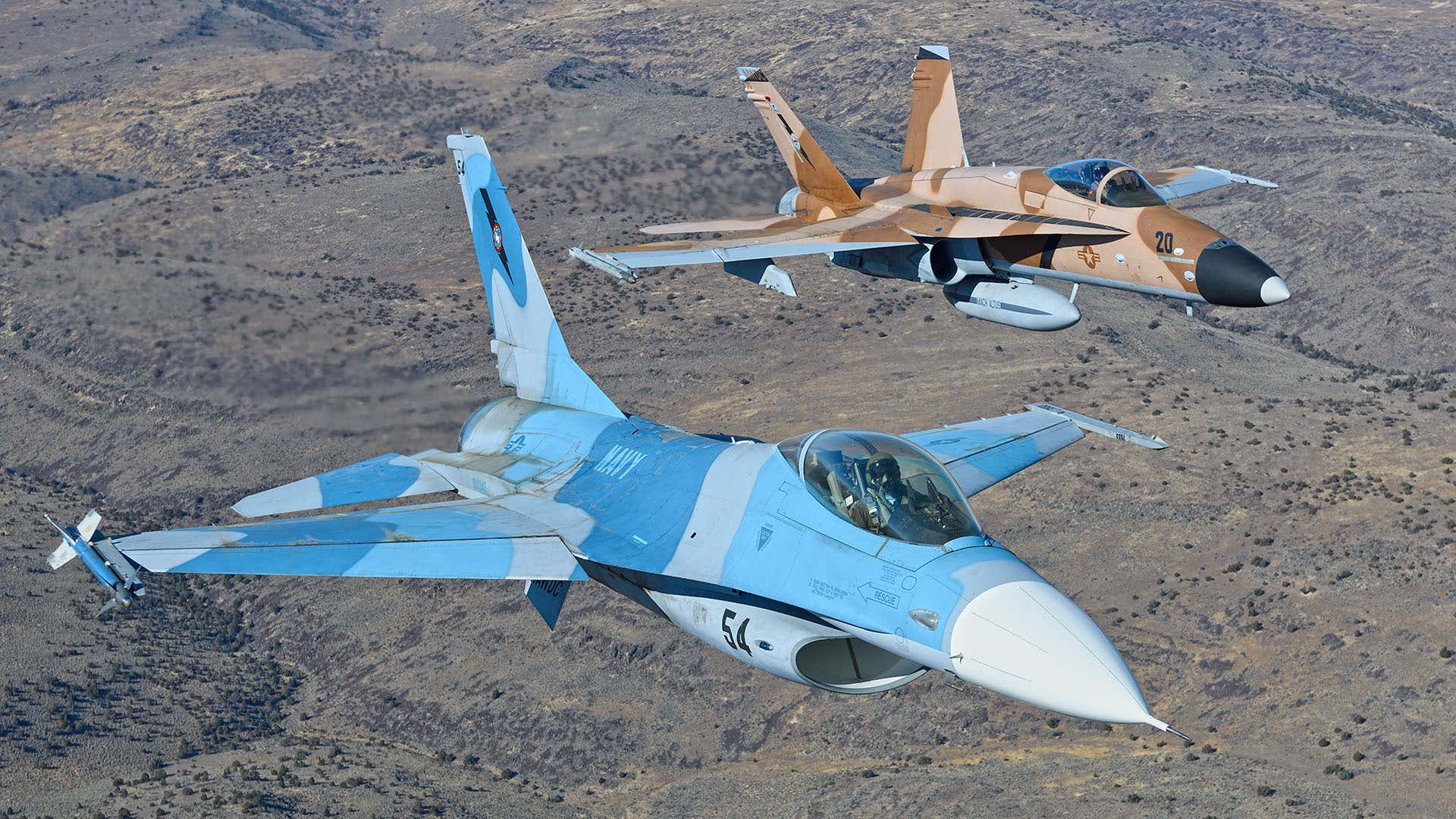As first reported by The War Zone, the U.S. Navy is now lining up the acquisition of additional F-16 aggressor jets to supplement the F/A-18E/F Super Hornets that are now headed to one of its dedicated adversary squadrons, VFC-12, the “Fighting Omars,” based at Naval Air Station Oceana, Virginia. The F-16s are required since there’s a shortage of the earlier Block I Super Hornets available for the high-end adversary mission.
The move was confirmed recently by Seapower Magazine, who quoted Vice Admiral John Mustin, chief of Navy Reserve, in his statement to the defense subcommittee of the House Appropriations Committee on May 4. Mustin outlined plans to boost the Navy’s high-end adversary force with second-hand F-16s drawn from Air Force and Air National Guard stocks.

The plan to add more Vipers on top of those F-16A/Bs already operated by Topgun instructors at Naval Air Station Fallon, Nevada, is just one part of a revamp of the adversary fleet that Mustin recommended. He also called for upgrades to these jets, including infrared search and track systems and further evolution of the ‘Red Net’ tactical and situational awareness datalink that you can read more about here.
It also follows the trend established by the U.S. Air Force when that service announced it was to enhance its aggressor capabilities by using early examples of the F-35A and younger F-16C/Ds to equip the 65th Aggressor Squadron.
The possibility of acquiring more Navy F-16 aggressors emerged last year and was addressed in this piece of ours detailing the Navy’s plans to replace the ‘legacy’ Hornets within VFC-12 for early examples of the F/A-18E/F Super Hornet. That transition is scheduled to be completed by October this year and it will also bring some new color schemes representative of aircraft flown by certain threat nations.
In the process, VFC-12 will become the first Navy aggressor unit to fly the Super Hornet as part of the Navy’s ongoing process of retiring the ‘legacy’ Hornet, although Topgun also operates a handful of F/A-18E/F, toos. Many of the ‘legacy’ Hornets have extremely high flight hours, making them increasingly costly to operate, with a stated cost per flight hour for the type pegged at $44,000. The new jets will also bring some notable enhancements to meet increasing demands for more robust ‘bandit’ threat training.

But that leaves another high-end adversary squadron, VFA-204, the “River Rattlers,” still flying ‘legacy’ Hornets out of Naval Air Station Joint Reserve Base New Orleans, Louisiana. Between them, VFC-12 and VFA-204 now fly 27 F/A-18A+ and C/D model Hornets and with VFC-12 poised to swap its jets for Super Hornets, VFA-204 would likely receive the second-hand F-16s. Otherwise, only the U.S. Naval Test Pilot’s School (TPS), and the Naval Fighter Weapons School, better known as Topgun, are still flying the Navy ‘legacy’ Hornets.

Outside the high-end adversary community, the Navy also flies 31 F-5N/F Tiger II jets for replicating low-to-mid level threats. These serve with VFC-13 at Fallon and VFC-111 at Naval Air Station Key West, Florida and the force will be expanded by adding another 11 F-5E/F aircraft acquired from Switzerland, starting next year.
As for the F-16, the Navy has flown these aggressor platforms before, taking 26 examples of the purpose-built F-16N version purchased in the mid-1980s. The full fascinating story of these ‘hotrod’ jets was told in this previous feature by a former pilot and Topgun instructor, but the F-16N was controversially retired in the mid-1990s.

Ultimately, the Navy did acquire more F-16s, less than a decade after the F-16N was retired, taking 14 of the F-16A/Bs that had been built for Pakistan before being embargoed. These were delivered to the Naval Strike and Air Warfare Center (NSAWC) in 2002-03 and operated on behalf of the Topgun program. Topgun maintains its own training program to convert experienced Naval Aviators from the service’s other tactical jets to the F-16. This could potentially be expanded if more of the type are added to the Navy’s stable.
As well as the Air Force’s 18th Aggressor Squadron (AGRS) at Eielson Air Force Base in Alaska and the 64th AGRS at Nellis Air Force Base, Nevada, the F-16 is now in the hands of private contractors offering ‘red air’ services to the U.S. military, and above all in support of the Air Force’s mammoth Adversary Air Support Contract. These ex-Israeli F-16s belong to the Top Aces firm, whose Viper plans you can read more about here and here.
With VFC-12 moving over to the Super Hornet, adding F-16s to VFA-204 would mean Navy fleet pilots can go head-to-head with a dissimilar high-end type, bringing another level of realism to the training and better preparing them for the kinds of threats they could face on deployment.
Should VFA-204 get the F-16s, it would lose its secondary tasking of acting as a reserve force in times of crisis, which makes it, as of now, “the Navy Reserve’s only remaining Strike Fighter Squadron available for contingency deployment.” As part of that, VFA-204 periodically conducts carrier qualifications, clearly impossible with F-16s.

Vice Admiral Mustin also disclosed that, in Fiscal Year 2020, the Navy’s appetite for adversary support was such that active-duty strike fighter squadrons had to take up the slack to the tune of 13,129 flight hours — more than half of the service’s total in-house ‘red air’ demand. That is clearly far from ideal, using front-line platforms’ precious flying hours for a mission that provides little organic training to those flying it, and demonstrates why re-equipping existing Navy aggressor units is so critical.
Mustin didn’t provide a timeline for when the Navy wants to introduce new F-16s, but it’s clear that divesting the last ‘legacy’ Hornets is a priority right now.
With suitable Super Hornets in short supply and a seemingly insatiable need for aggressors to push fleet pilots to the limit, the highly proven F-16 looks like it could be an ideal solution to upgrade the Navy’s high-end adversary fleet.
Contact the author: thomas@thedrive.com
